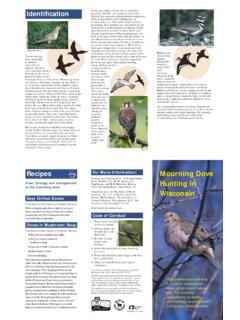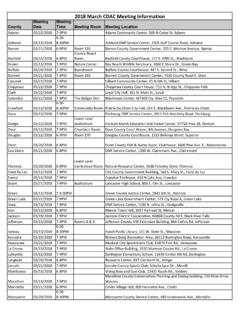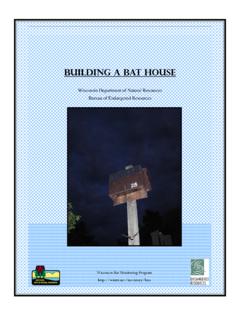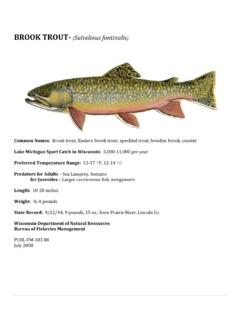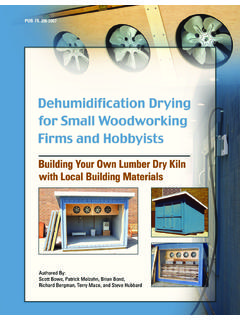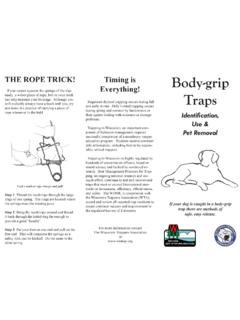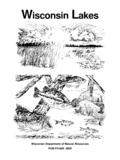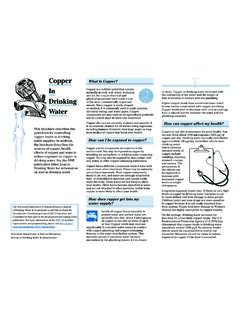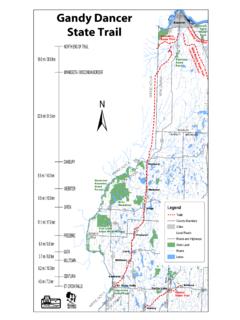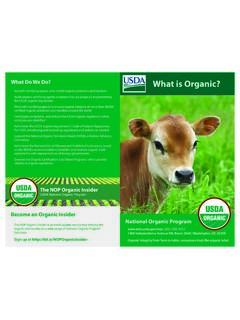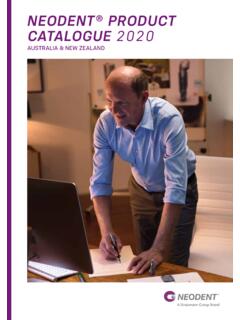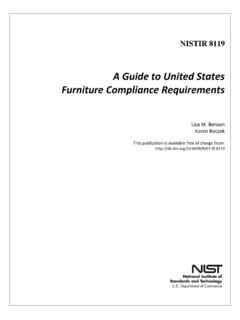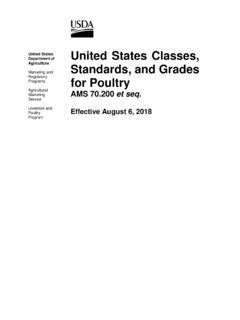Transcription of Introduction To Activated Sludge Study Guide - Wisconsin …
1 Wisconsin Department of Natural Resources Wastewater Operator Certification Introduction To Activated Sludge Study Guide December 2010 Edition Subclass C. Wisconsin Department of Natural Resources Bureau of Science Services, Operator Certification Program Box 7921, Madison, WI 53707. The Wisconsin Department of Natural Resources provides equal opportunity in its employment, programs, services, and functions under an Affirmative Action Plan. If you have any questions, please write to Equal Opportunity Office, Department of Interior, Washington, 20240. This publication is availab le in alternative format (large print, Braille, audio tape. etc.) upon request. Please call (608) 266-0531. for more information. Printed on 12/11/12. Introduction To Activated Sludge Study Guide - December 2010 Edition Preface This operator's Study Guide represents the results of an ambitious program.
2 Operators of wastewater facilities, regulators, educators and local officials, jointly prepared the objectives and exam questions for this subclass. How to use this Study Guide with references In preparation for the exams you should: 1. Read all of the key knowledge's for each objective. 2. Use the resources listed at the end of the Study Guide for additional information. 3. Review all key knowledge's until you fully understand them and know them by memory. It is advisable that the operator take classroom or online training in this process before attempting the certification exam. Choosing A Test Date Before you choose a test date, consider the training opportunities available in your area. A listing of training opportunities and exam dates is available on the internet at , keyword search "operator certification".
3 It can also be found in the annual DNR "Certified Operator" or by contacting your DNR regional operator certification coordinator. Acknowledgements This Study Guide is the result of the efforts of the following workgroup individuals: Chris Marx, Chilton WWTP. Matt Schmidt, Green Bay Metro Joe Flanagan, Blanchardville WWTP. Gary Hanson, AECom Doug Nelson, Ruekert & Mielke Jim Shaw, ITT Sanitaire Dan Tomaro, Wastewater Training Solutions Curtis Nickels, WIDNR-Plymouth Hannah Fass, WIDNR-Madison Amy Schmidt, WIDNR-Madison Jack Saltes, WIDNR-Madison Printed on 12/11/12. Introduction To Activated Sludge Study Guide - December 2010 Edition Table of Contents Chapter 1 - Theory and Principles Section - Definitions pg. 1. Section - Microbiological Principles pg. 3. Section - Process Variations pg. 6. Chapter 2 - Operation and Maintenance Section - Definitions pg.
4 9. Section - Methods pg. 10. Section - Equipment pg. 12. Section - Preventative Maintenance pg. 14. Chapter 3 - Monitoring, Process Control, and Troubleshooting Section - Definitions pg. 16. Section - Sampling & Testing pg. 17. Section - Data Understanding & Interpretation pg. 19. Section - Side Streams/Recycle Flows pg. 20. Section - Performance Limiting Factors pg. 21. Section - Corrective Actions pg. 22. Chapter 4 - Safety and regulations Section - Definitions pg. 23. Section - Personal Safety pg. 23. Section - Chemical pg. 24. Chapter 5 - Calculations Section - Tank Volume pg. 25. Section - Flows/Loadings pg. 25. Section - Sludge Age pg. 26. Section - Food to Microorganism Ratio pg. 26. Section - Sludge Volume Index pg. 27. Printed on 12/11/12. Introduction To Activated Sludge Study Guide - December 2010 Edition Chapter 1 - Theory and Principles Section - Definitions Define Activated Sludge .
5 Activated Sludge is a mixture of bacteria, fungi, protozoa and rotifers maintained in suspension by aeration and mixing. Define secondary treatment. A term to describe the biological treatment of wastewater. Activated Sludge is a type of secondary treatment. Secondary treatment provides a high level of removal of biodegradable organic pollutants to protect receiving water quality that clarification alone cannot provide. Define clarification. A process to reduce the concentration of suspended matter in water. In the Activated Sludge treatment process, the removal of suspended solids from wastewater is usually through gravity separation in a clarifier. Define waste Activated Sludge (WAS). The Activated Sludge (excess biomass or cell mass) removed from the secondary treatment process. For most treatment plants, this will be a portion of the Return Activated Sludge (RAS) flow stream.
6 Define return Activated Sludge (RAS). The settled Activated Sludge (biomass) that is collected in a secondary clarifier and returned to the secondary treatment process to mix with incoming wastewater. This returns a concentrated population of microorganisms back into the aeration basin. Define Sludge volume index (SVI). A numerical expression of the settling characteristics of Activated Sludge in the final clarifier. SVI is expressed as the ratio of the volume in milliliters of Activated Sludge settled from a 1,000-mL sample in 30 minutes divided by the concentration of mixed liquor in milligrams per liter multiplied by 1,000. A good settling Sludge (textbook value) is 100, but can commonly be between 80-150. Define food to microorganism ratio (F:M or F/M). Food to microorganism ratio (F:M or F/M) is the amount of food (BOD5) provided to the microorganisms (MLVSS or MLSS) in the aeration basins.
7 F/M is determined by dividing the pounds of influent BOD5 by the pounds of mixed liquor volatile suspended solids or mixed liquor suspended solids under aeration. Define mixed liquor suspended solids (MLSS). The amount of suspended solids in an aeration tank, expressed in milligrams per liter Page 1 of 28 Printed on 12/11/12. Introduction To Activated Sludge Study Guide - December 2010 Edition (mg/L). MLSS consists mostly of microorganisms and non-biodegradable suspended matter. Total pounds of MLSS in an aeration tank can be calculated by multiplying the concentration of MLSS (mg/L) in the aeration tank by the tank volume (MG), and then multiplying the product by (lbs/gal). Define mixed liquor volatile suspended solids (MLVSS). The amount of organic or volatile suspended solids in an aeration tank, expressed in mg/L.
8 This volatile portion is used as a measure of the microorganisms present in the aeration tank. Total pounds of MLVSS in an aeration tank can be calculated by multiplying the concentration of MLVSS (mg/L) in the aeration tank by the tank volume (MG), and then multiplying the product by (lbs/gal). Define Sludge age. Sludge age is the theoretical length of time a particle of Activated Sludge stays in the treatment plant, measured in days. In an Activated Sludge plant, Sludge age is the amount (lbs) of mixed liquor suspended solids divided by the suspended solids, or excess cell mass, withdrawn from the system per day (lbs per day of waste Activated Sludge ). Define nitrification. A biological process where nitrifying bacteria convert nitrogen in the form of ammonia (NH3) into nitrite (NO2-) and nitrate (NO3-) under aerobic conditions.
9 Define denitrification. A biological process where bacteria convert nitrate (NO3-) and nitrite (NO2-) to nitrogen gas (N2) under anoxic conditions. Define floc. Clusters of microorganisms and solid particles that form in the Activated Sludge process and settle in the final clarifier. Define Sludge blanket. The Sludge blanket is the layer of solids on the bottom of the clarifier. Define aerobic (oxic) [O2]. A condition in which free and dissolved oxygen is available in an aqueous environment. Define Anoxic [NO2, NO3, SO4]. A condition in which oxygen is only available in a combined form such as nitrate (NO3-), nitrite (NO2-), or sulfate (SO4) in an aqueous environment. Define Anaerobic [ ]. A condition in which free, dissolved, and combined oxygen is unavailable in an aqueous environment. Define Protozoa.
10 Page 2 of 28 Printed on 12/11/12. Introduction To Activated Sludge Study Guide - December 2010 Edition Protozoa are single celled microscopic organisms that require oxygen and food (bacteria). for growth and reproduction. Protoza include amoeba, flagellates and ciliates. Define organic loading and organic overload. organic loading is the amount of biodegradable material that exerts an oxygen demand on the biological treatment process. The organic strength of the wastewater is usually measured as biochemical oxygen demand (BOD) in milligrams per liter (mg/L). An organic overload is an event which significantly increases the organic loading (BOD) to the aeration basin above normal influent organic loading conditions. Define weir(s). A weir is a level control structure (often v-notched) in a final clarifier used to provide a uniform effluent flow.

